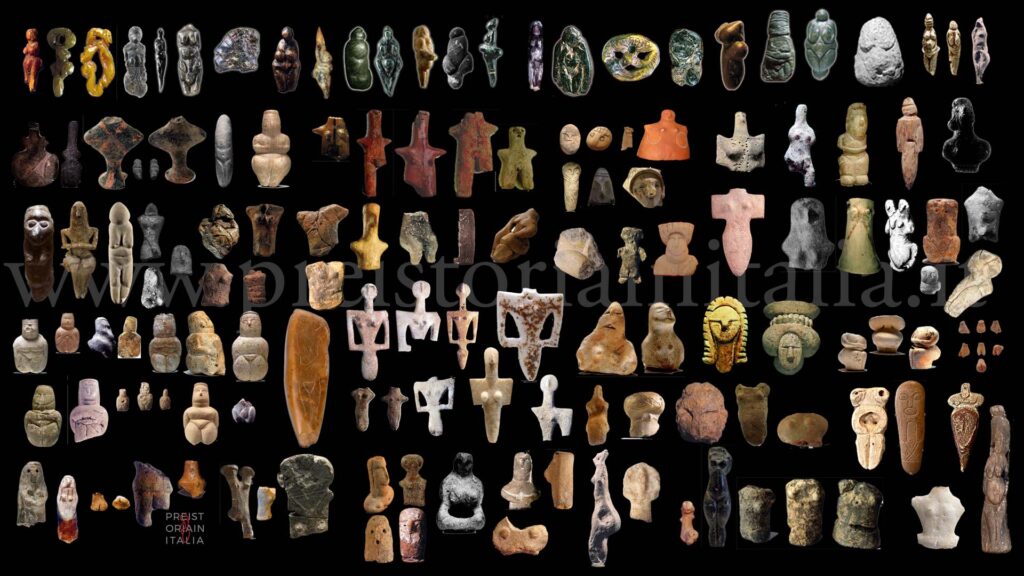Taken from: Anne Baring and Jules Cashford – THE MYTH OF THE GODDESS – The origins: the Paleolithic Mother Goddess – Venexia – October 2017
Long ago, perhaps 20.000 years or more, the image of a goddess appeared across a vast territory stretching from the Pyrenees to Lake Baikal in Siberia. Stone, bone, ivory statues, tiny threadlike figures with pendulous breasts, rounded pregnant and parturient maternal effigies, figures engraved with lines, triangles, circles, nets, leaves, spirals; hollow, and full of grace, sprouting from the rock colored red ochre, they have all survived through voiceless generations of human beings.
At what time in human history did these sacred images appear? … When the glaciers that had covered much of Europe and Asia began to melt, sometime between 50.000 and 30.000 BC (although they didn't completely disappear until 10.000 BC), a human being appeared with whom one can feel kinship: Homo sapiens. Before that, very few animals could live on the frozen ground, except the woolly mammoth, rhinoceros and reindeer. … Later, between 20.000 and 15.000 BC, the grasslands gave way to dense forests and herds pushed east, followed by hunters. Some tribes remained behind, such as those from southwestern France, who settled in caves in the fertile valleys of the Dordogne, Vézère and Ariège. The wall painting of the caves and the sculpture of the goddesses dates back to that period.
More than 130 statuettes, lying on the rocks or on the ground, were discovered among the bones and tools of the Paleolithic populations… The statues, generally small, were always naked and often pregnant. Some looked like mere women, but most looked like mothers, as if everything feminine about them was focused on the overwhelming mystery of birth. Many icons were smeared with red ochre, the color of living blood, and often narrowed to a footless spot, as if they had once been driven vertically into the ground for a ritual purpose. The tribes who lived in these caves, painting the dark walls with figures of wild animals colored in bright red, ocher and brown, placed the statuettes outside the caves, at the entrance to their homes or sanctuaries.
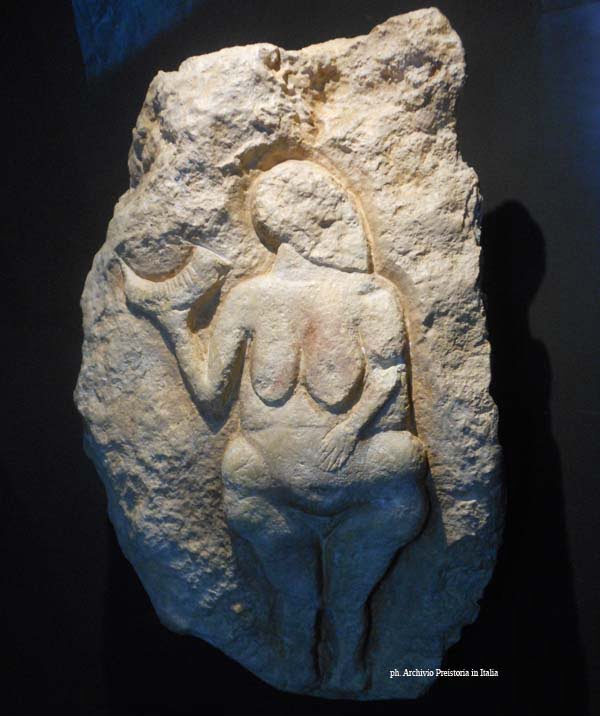
Above a rock shelter in Laussel, in the Dordogne, a few miles from the great cave of Lascaux… the figure of a woman, 43 centimeters tall, once gazed out over the valley. The Paleolithic sculptors carved it on a limestone rock with flint tools and placed in her right hand a bison horn in the shape of a crescent moon, with notches symbolizing the thirteen days of the waxing phase and the thirteen months of the lunar year, while with the left hand points to his swollen belly. The head is inclined towards the horn of the crescent moon, drawing a curve that relates it to the woman's fingers on the belly, thus creating a link between the crescent phase of the moon and the fecundity of the human womb... (FIGURE 1).
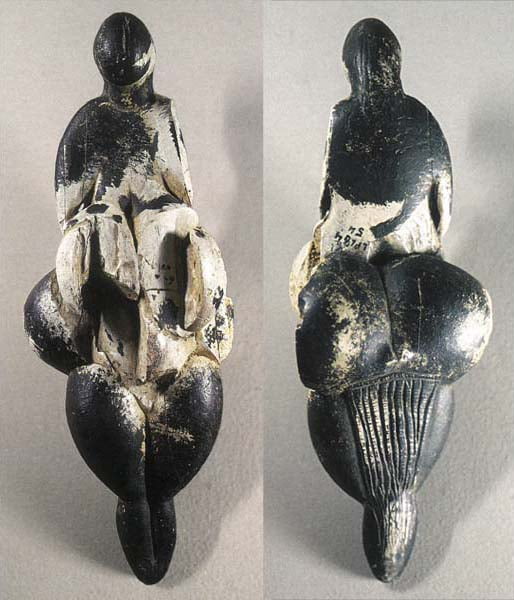
One hundred miles south, in the foothills of the Pyrenees, at a place called Lespugue, submerged in a mud gully, lay the delicate figurine of FIGURE 2 for millennia. Carved from mammoth ivory, it is only 14 centimeters tall. It has no hands or feet, and the legs that narrow to one point suggest that it was fixed in the ground or in wood in order to be able to stand and show itself. The upper chest is flattened in a curve towards the head, almost snakelike, bent forward, so that all the emphasis of her frail body falls on her ability to bear and nurture.
The arms rest on the large drooping breasts that merge with the swollen and full belly, the buttocks and thighs are disproportionately large, as if they contributed to the act of giving life. Breasts and buttocks give the impression of four large eggs contained in the nest of her pregnant body. Ten vertical lines have been incised from the tip of the buttocks to the back of the knees, suggesting that the waters of birth must fall from the uterus copious as rain. The ten lines allude to the ten lunar months of gestation.
… The only thing we can be certain of is that we are faced with female figures. We can interpret them as representations of real women or as abstract female figures, or as women whose specific characteristics have ritual significance, who have been disclosed to convey something beyond what any particular woman is or does. No similar male figures have been found. Why, then, should the figure of a woman, or more precisely the figure of a pregnant woman, be ritualized?
We abandon the testimony and come to the interpretation. The mystery of the female body is the mystery of birth, which is also the mystery of the unmanifest which becomes manifest in the whole of nature. All of this far transcends the female body and the woman as bearer of this image, the body of the female of any species in fact leads, through the mystery of birth, to the very mystery of life.
Recognizing the religious significance of these figures, we are not permitted to dismiss them as "fertility idols". The term "idol" inevitably trivializes the numinosity of religious experience, being used only for the forms of worship of others, and the word "fertility," so grandiose, ignores the fact that even today many pray that the Virgin Mary give them children. Similarly, to call them “figurines of Venus” (as the Venus of Laussel or the Venus of Lespugue are usually called), is to reduce the universality of a first principle, the Mother, to the name of the Roman goddess of love, who was only one of many goddesses supplanted by the Father god as ruler, if not creator, of the world. Therefore, in trying to restore their original dignity to the Paleolithic figures, we prefer to attribute to these sacred representations of the power of the universe to give life, nourish and regenerate, the name of "Mother Goddess", or simply "Goddess". …
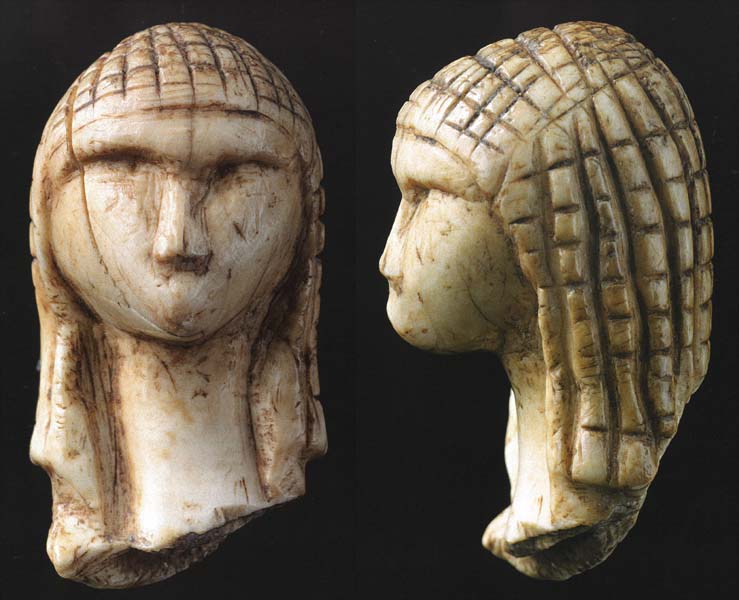
The oldest Goddess sculpture, from around 22.000 BC, is the one that looks the most modern. Only the tiny head remains of her (FIGURE 3). Just three and a half centimeters tall, she had been carved from mammoth ivory with fine and delicate features, a slender neck framed by long straight hair, a very peculiar nose and eyebrows, and even more particular the design of a net precisely chiseled for the entire length of the hair. She comes from Brassempouy, in the Landes region of France.
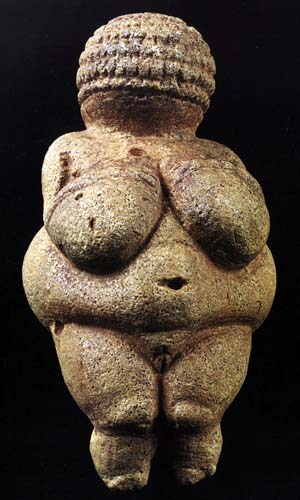
… Moving to the East, the Goddess of Willendorf, in Austria (FIGURE 4), despite being only 11 centimeters tall, appears to us in all her grandeur.
Made of limestone, the weight of fertility roots it in the earth, making it feel like part of it. The centripetal heaviness of her body – where breasts, belly and thighs re-enter a circle and the arms rest on the enormously turgid breasts – forms a sharp contrast with the head finely chiselled with symbols. The curiously bulbous head is divided vertically into seven layers, each of which is incised horizontally along its length, giving the appearance of seven circles. The number seven – which represents a quarter of the full cycle of the moon and is the number of planets in motion – may be a coincidence, but it certainly was the sacred number of the Whole at the time of the Bronze Age (c. 3500 BC), 15.000 years After.
The abundance of the breast is the essential image of trust in the universe, just as the stars were considered and depicted as iridescent pearls of milk that flowed from the breast of the Mother Goddess (it is no coincidence that the galaxy ended up being called the Milky Way ) …
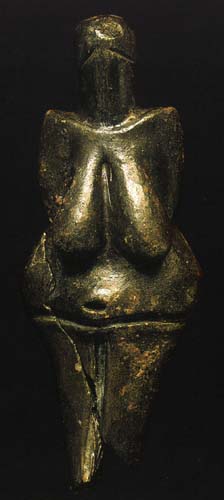
The strange Black Goddess (FIGURE 5) found in Dolni Vestonice near a hearth, was sculpted in clay and bone dust and made hard, like stone, by firing. His face has two oblique cuts for the eyes at the top, a mark for the nose and at the top of the head four clay holes to hold flowers, leaves or feathers, which descended like “hair” or “headdress” – an image that perhaps explores how plants grow. Here too the impression of fecundity predominates: this is demonstrated by the shape of the sagging breasts followed by the swollen curve of the hips and belly, and the large navel-hole which emphasizes the umbilical cord by replacing the absent vulva. The legs end in a point: it is probable that it was placed in the ground, in wood, or perhaps carried in the hand.
The Goddess, source of life, was also often represented in an abstract way with the shape of a triangle or in a marked division of the open legs as an entrance to the uterus. More than XNUMX images of the vulva are found in Paleolithic France alone, evidence that tales of the life-giving Goddess were so familiar as to be recognized instantly. Sometimes the vulvas have signs and shoots drawn on or next to them; others bear engravings that imitate the movement of rippling water, a reminder that the cosmic womb was recognized as the source of the plant world and as the water of life. …
Moving further east, in Siberia, precisely in Mal'ta, an extraordinary funerary site was discovered near Lake Baikal, dated around 16.000-13.000 BC; at this site, along with fourteen animal burials, there were at least 20 mammoth ivory Goddess figurines, 3,2 to 13,3 centimeters tall, one of them apparently dressed in a lion's skin. The small, slim Goddess of FIGURE 6 has unusually defined arms, with emphasized breasts and head and, again, tapering legs which allow us to imagine her standing, fixed in the ground, just like the Goddess of Lespugue.
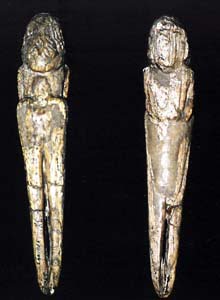
The similarity of many goddess figures, from France to Russia, suggests that there was a continuity of religious structure extending from Europe to Siberia, wholly unimaginable before XNUMXth-century excavations.
Taken from: Anne Baring and Jules Cashford – THE MYTH OF THE GODDESS – The origins: the Paleolithic Mother Goddess – Venexia – October 2017

